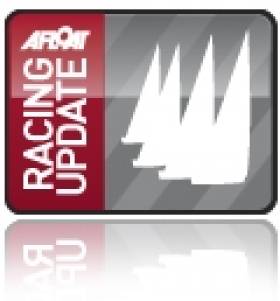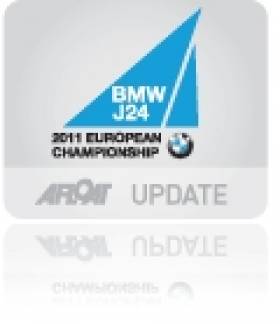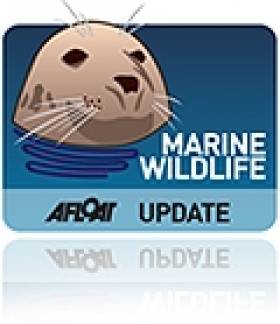Displaying items by tag: yacht
Ferry Stops, 'Sea Water Baths' on the Way for Dun Laoghaire
The last Stena line ferry sailing from Dun Laoghaire featured on the RTE News headlines last night. The ferry link is stopping because of a decline in passenger numbers and the high cost of fuel, say the operators, Stena.
The report by John Kilraine, interviewed Harbour Boss Gerry Dunne who spoke about the master plan for the harbour, how the harbour company hoped that Stena could rebuild the route, the bid to attract cruise ships and the east coast port's future as a marine leisure centre.
The masterplan is to go through the planning processs piece by piece and harbour yacht clubs have concerns over aspects of the plan.
Last night's bulletin also reported the harbour company intends to open a 'sea water baths' in the harbour next year and a diaspora centre in 2013. The RTE report is here.
See also:
O'Leary Set for Tomorrow's New York Cup
Anthony O'Leary's crew are all set for tomorrow's start of the New York Yacht Club Invitational Cup as sole Irish crew representing Royal Cork Yacht Club in the Big Apple.
The grounds of New York Yacht Club's renowned Harbour Court clubhouse in Newport, Rhode Island, were filled with sailors from around the world, who are set to begin racing tomorrow in the second biennial Invitational Cup presented by Rolex.
The 22 teams, representing yacht clubs from 16 nations and six continents, have traveled far and wide to get to Newport. The teams, especially those less familiar with the Swan 42 class, enjoyed several perfect practice days with today's 12-14 knot southwesterly breeze, under sunshine and brilliant blue skies, appreciated by all competitors, especially those from some more sunshine-challenged locales
The Swan 42s, an ultra competitive one-design class, were conceived by the NYYC as the yacht club's ninth one-design class since its' founding in 1844. The New York Yacht Club Race Committee, led by John "Tinker" Myles, Jr. ran several practice starts today for the fleet.
Racing will run from Tuesday, 13 September through Saturday, 17 September. A total of eleven (windward-leeward) races are planned, with no throw-outs. Racing will take place off Newport, R.I. on Rhode Island Sound or in Narragansett Bay.
One of the first teams to arrive in Newport was Clube Naval de Cascais from Portugal, with skipper Patrick Moteiro de Barros. The team has been on-site for over a week practicing on their chartered Swan 42 Orbit, and making the most of coach Bill Shore's expertise and local knowledge. de Barros commented, "The goal is to do the best we can, and we're here to win. We may not win, but that's the motivation."
To that end de Barros, who is a four-time Olympian, has assembled a crew that at its' core are very competitive Dragon sailors. Included in this mix is tactician Henrique Anjos, a three-time Portuguese national champion in the class. With no Swan 42s available locally, the team came up with a clever alternative last spring, chartering a Dufour 40, and adding a bowsprit to it so they could fly an asymetrical spinnaker.
De Barros is no stranger to Newport, having sailed here in the 1980s when he was the helmsman on Magic, the trial horse for Dennis Conner's Freedom. The team had hoped to participate two years ago, but couldn't come, and the appeal of the event is clear to de Barros who added, "The Invitational Cup is totally Corinthian, and I think it's important to have events where the amateurs are recognized. This is one of the most prestigious yacht clubs in the world, and I think events like this should carry on."
From further afield is the Royal Hong Kong Yacht Club team with skipper Nick Burns. Sailing onboard is Jochim Isler, Vice Commodore of the club and a frequent competitor in the RHKYC's signature biennial Rolex China Sea Race. As with many of the other clubs, the teams experience is in a mix of big boats and one-designs, in this case Etchells. Burns and Isler often compete against each other, but they've solidified their strengths as well as recruited 10 of the top 20 sailors in the club for the team.
In the 2009 event, Royal Hong Kong finished 11th; but last summer they sailed in the Rolex Commodore's Cup and finished second, which Isler said gave them the confidence and motivation to give it a try again.
Burns added, "We came a long way for this, it's great. The event is tightening up (rules) year-by-year, which is what you need. They're doing a very equal job with the boats, it's a very good system. You have nothing to blame but yourself!"
One of the Southern hemisphere teams competing is the Yacht Club Argentino with Paolo Cosentino as helmsman. YCA Commodore Ricardo Galarce is racing onboard as trimmer, and the two were clearly delighted to be here, "This is our first visit and I tell you we are amazed, we want to live here, we're going to stay here."
Cosentino said, "We sail two boats that are similar (a Frers 44 and a Soto 43). We trained about 10 days in Buenos Aires (in the river) and Mar del Plata, where you can sail in the sea. We feel comfortable, but need to train a little more – we've had these three days here, so we'll arrive tomorrow at about 80% of our standard.
"For us we are very proud of being invited by this club. We have a lot of tradition also, our club is almost 130 years old and for us being here is a very special situation – we are very proud."
For NYYC Invitational Cup Event Chairman, John Mendez tomorrow's start couldn't come soon enough, "I'm absolutely delighted. To be honest it's been a long build-up, it's been two years getting this going and to see all of the teams arrive and to meet with them – their excitement and enthusiasm -- has really set this off for me. I feel a lot more relaxed about the whole event!"
About half of the yacht club teams that competed in 2009 are back again, including the top five. Mendez continued, "We still have a lot of interest from yacht clubs that are not here and as this has grown they'll be a lot more who'll want to participate next time. I see the competition this time being stiffer than last time – it has been raised to another level. I think we'll see some exciting racing.
"This is key to each one of these clubs – they all have the intention of taking the trophy back with them. I'm afraid we can't cut it into pieces! But, I could see the trophy leaving our shores at the end of the week."
This edition features a couple of significant changes including a move to all-amateur sailors (no professionals) and on-the-water umpiring. Of the latter Mendez points out, "That's a very big leap forward for fleet racing. We want people to sail safely and the umpiring is definitely going to help that."
In addition to Rolex, which for 2011 and 2013 is the presenting sponsor, Sperry Top-Sider and Nautor's Swan have also returned, and are joined by Atlantis WeatherGear, as sponsors to enhance the experience of competitors as well as those who will be following the races.
The 22 entrants
By country, the roster of participating teams is: Yacht Club Argentino (ARG); Cruising Yacht Club of Australia (AUS); Royal Bermuda Yacht Club (BER); Royal Canadian Yacht Club (CAN); Royal Hong Kong Yacht Club (CHN); Real Club Nautico de Barcelona (ESP); Nyländska Jaktklubben (FIN); Itchenor Sailing Club, Royal Ocean Racing Club and Royal Yacht Squadron (GBR); Norddeutscher Regatta Verein (GER); Royal Cork Yacht Club (IRL); Yacht Club Capri and Yacht Club Punta Ala (ITA); Japan Sailing Federation (JPN); Royal Norwegian Yacht Club (NOR); Clube Naval de Cascais (POR); Royal Cape Yacht Club (RSA); Eastern Yacht Club, Annapolis Yacht Club, Newport Harbor Yacht Club and New York Yacht Club (USA)
J24 Euros Open in Howth, Strong Winds Cancel Practise Race
The BMW J/24 European Championships were officially opened last night with a ceremony on the forecourt in front of the Howth Yacht Club clubhouse on the podium erected by the sponsor but a practise race scheduled for this afternoon was cancelled due to strong winds.
Last night's openning ceremony featured two top-of-the range BMW vehicles and a motorcycle and a backdrop with the highly appropriate phrase of 'Joy is Plain Sailing' in front of the national flags of the nine competing nations.
With an audience of competitors, supporters and club members, the speakers on the podium were introduced by the 'Master of Ceremonies', Club and Championship Press Officer Graham Smith.
First to speak was Derek Bothwell, Chairman of the Championship Organising Committee, and then the Commodore Roger Cagney addressed the large crowd who has assembled on the forecourt and balcony. They were followed by John Ives, Managing Director of BMW Ireland, the title sponsors, who spoke about BMW's global involvement in sailing, and then Niamh McCutcheon, President of the Irish Sailing Association, spoke on behalf of the ISA and the Irish Sports Council who supported the event.
Jim Farmer, President of the World Council of the International J/24 Class Association, spoke next, and the final speaker was the Mayor of Fingal, Cllr.Gerry McGuire, who welcomed all the overseas visitors to the county and officially declared the Championship open.
Lough Derg Lifeboat Rescues Three after Yacht Capsizes
At 17.04hrs Saturday September 10, Lough Derg RNLI Lifeboat was requested to launch by Valentia Coast Guard following a report of two persons in the water off Hare Island, on Lough Derg. At 17.15hrs, the lifeboat was launched with Helm Colin knight, Johnny Hoare and Ger Egan on board, and was on scene 17.20hrs. The wind was southwest, force 6, with a 5ft to 6ft swell, visibility was good.
When the RNL lifeboat arrived on scene, a passing yacht was recovering two persons onto their yacht, but had lost a visual on the third person. The lifeboat immediately carried out a search pattern, located the third casualty some four or five hundred metres away, and recovered them to the lifeboat.
Lifeboat Helm Colin Knight said "these three people were very very lucky; the passing yacht only became aware of their plight when, on tacking, one of sailors heard calls for help on the wind and raised the alarm". He continued, "the persons were in the water for at least thirty minutes, in fairly hostile conditions, when the only boat in the vicinity heard their calls for help, someone was looking after them today".
Tasked by Valentia Coast Guard, the Irish Coast Guard Search & Rescue Helicopter team, Rescue 115, took off from their base at Shannon at 17.34hrs. Killaloe Coast Guard had also launched to assist. After establishing that the RNLI lifeboat could be at their station within 5 minutes, Rescue 115 requested the crew to take the casualties to Dromineer from where they5 would transfer the casualties to hospital.
The RNLI lifeboat returned to the yacht, and took a second casualty on board. Killaloe Coast Guard boat took the third person. All were then rushed back to Drominneer where they were met by the helicopter and transferred to Limerick Regional hospital for further treatment.
The lifeboat then returned to 'The Hare' to see if the sunken vessel was a navigational hazard, but there was no sign of wreckage or of the yacht. The lifeboat returned to station and was ready for service again at 18.50hrs.
Dun Laoghaire Yacht Clubs Voice Concern Over Plan
Dun Laoghaire Yacht Clubs are voicing concerns about the impact on sailing if a 'cruise ship jetty' is constructed as part of the recently published harbour masterplan.
Dublin Bay Sailing Club, Dun Laoghaire Motor Yacht Club, National Yacht Club, Royal Alfred Yacht Club
Royal Irish Yacht Club and Royal St George Yacht Club. are also concerned about access to the water if a proposed 'pedestrian walkway' in front of the waterfront clubs was completed.
The clubs have engaged 'professional help' to prepare a submission to outine the concerns.
Also seen as a problem is the 'lack of sufficient facilities in the masterplan for hosting significant international sailing events'.
A survey in 2009 by the Irish Marine Federation (IMF) calculated a €3million spend by participants connected with the 500-boat Volvo Dun Laoghaire regatta. The clubs have previously stated they see the harbour's future as a leisure facility.
A masterplan model was on display by the Harbour Company in the month of August.
Writing to members in the current edition of the National Yacht Club's newsletter commodore Paul Barrington says the clubs 'hope to further engage with the harbour [company] to find a mutually acceptable way forward'.
Water Rat: Harbour Plan is a Curate's Egg
Celtic Mist Will Track Elusive Blue Whale
The infamous Celtic Mist is set to be used to track one of the most elusive marine animals in Irish waters.
The Irish Examiner reports that one of the first duties of the yacht under its new ownership by the Irish Whale and Dolphin Group (IWDG) will be to track down the blue whale, the last of which was spotted off the Irish coast in 2009.
"We’ve made two sightings of the blue whale on the shelf edge but with the Celtic Mist we will be able to go out there for a few weeks and sit there and wait for them," said the IWDG's Dr Simon Berrow.
"Hopefully we will find some more when we bring the Celtic Mist out there. They are very rare."
The blue whale is regarded as the largest animal to have ever lived on earth. They also have an average lifespan of well over 100 years.
As previously reported by Afloat.ie, Celtic Mist was gifted by the Haughey family to the IWDG earlier this year to assist in its marine conservation work.
The yacht competed in a leg of the 2011 Tall Ships Race from Waterford to Scotland before moving to its new home in Co Clare, where it will be refitted for its new life as a research vessel.
O'Leary's Set for New York Show Down
Royal Cork's Anthony O'Leary returns to New York's Invitational Cup next week for another crack at the Rolex event that has attracted 22 teams.
Despite no previous experience with the Swan 42, Anthony O'Leary's team from the Royal Cork Yacht Club got off to a blazing start at the 2009 Invitational Cup, scoring a third and two firsts in the opening three races. From there the team rode a bit of a roller coaster with three more top-five finishes, a 13th, and two 17ths. The end result was fifth, a bit disappointing given the quick start, but respectable, nonetheless. More importantly, it earned O'Leary and his team a return invitation.
When racing begins on Tuesday, September 13, at the 2011 New York Yacht Club Invitational Cup presented by Rolex, most of the 22 participating yacht club teams will be fresh from racing at the peak of the sailing season in the northern hemisphere.
Last year, O'Leary was named the Afloat Irish Independent Sailor of the Year for, in part, leading the Irish team to the win at the 2010 Rolex Commodore's Cup."We will continue to sail [the Ker 39] Antix up to mid-season in handicap fleets, as our boat is similar in characteristics to the Swan 42," says O'Leary of his preparations for the Invitational Cup. "Closer to September we will focus more on one-design sailing, which is really the ultimate challenge as shown in the Invitational Cup. Apart from our not finishing on the podium, there was not a single disappointing aspect of the 2009 regatta. The entire event was a great experience, superbly organized by a wonderful club."
O'Leary was still assembling his crew, but it will surely include some family members. Son Peter O'Leary sailed in the 2008 Olympics in the Star class while Nicholas O'Leary, a three-time All-Ireland sailing champion, served as the team's tactician during the 2009 Invitational Cup.
Three teams though – the Cruising Yacht Club of Australia, Royal Cape Yacht Club and Yacht Club Argentino – which hail from below the equator, will be coming from winter to summer to race in Swan 42s for the championship title. "It is an honor for the Yacht Club Argentino (YCA) to participate this coming September," said Commodore Ricardo Galarce. "We are proud of sharing such an important regatta with well-known clubs from different parts of the world.
Besides, it is nice to share with all of them the same objective of competing with fair play and sailing which is what we love doing. We will go to New York Yacht Club's Harbour Court ready to have fun, but we will be doing our best effort to take the cup back to our beloved YCA in Buenos Aires." Galarce explained that even though it is winter in Argentina, the weather is not so cold and the sailors are used to sailing in this season. After the invitation to the event was published in the YCA magazine, any club member who wanted to join the team was encouraged to do so. A team selection was then made taking into account sailing resumes, technical skills and personalities, in order to form a complete, competitive and compatible crew.
Because there was a boat similar to the Swan 42 available for their use in Mar del Plata, the YCA team traveled 400 km to spend a weekend there performing intensive training, "with very good results and lots of learning as regards each of the crew members' functions and movements," said Galarce. "We then carried on our training in Buenos Aires, always trying to sail in boats similar to the Swan 42, which we know is an excellent boat, which demands a lot from its crew." With only two of the crew having previously sailed in Newport – Santiago Braun and Francisco Billoch who each sailed the Onion Patch Series in 1972 – the YCA team is studying the weather forecasts, tides and winds, in order to gain some local knowledge. And the team hopes to become familiar with the Swan 42 in the short time between their arrival and the start of the Invitational Cup. "We know it won't be an easy regatta," concluded Galarce. "We are proud of being able to sail alongside sailors who belong to the most distinguished sailing clubs in the world. We wish them all good luck, and we hope to share great fun on the water."
In Australia where the average sailing temperature for the Cruising Yacht Club of Australia's (CYCA) winter series is 20 degrees Celsius (68 Fahrenheit), sailing is a year-round activity, and all of the CYCA team members race throughout the year in various club events. Most of the CYCA crew that will travel to Rhode Island sailed together for the first time in April on the Corby 49 Vamp in the New South Wales IRC championships, finishing third overall. Vamp then finished second in Division 1 in the recently concluded CYCA Winter series. "None of us have experience in the Swan 42s although most have sailed in similarly equipped and designed yachts over a range of sizes up to the TP52 class," said David Fuller, CYCA Team Manager. "Whereas we have not had many opportunities to sail together, most of our crew have continued to sharpen their skills on other boats in the various races and regattas along the Australian coast and overseas." CYCA tactician Evan Walker is one of those who have been away from Sydney, having recently been at Weymouth, England, to coach an Elliot 6m team at the 2012 Olympic test event.
Before coming to Newport, however, Walker will be racing as tactician in the Cartagena round of the Audi MedCup with an Australian Soto 40 team. "Hopefully the week of sailing as tactician in Spain will have me hitting my straps by the time I arrive in Newport," said Walker, a CYCA Youth Academy graduate who has seen success as a match racing skipper. "I'm very excited to be competing in the Invitational Cup and I'm sure we'll have an enthusiastic team bonding session on our arrival in Newport." David Hudson, skipper of the team from the Royal Cape Yacht Club (RCYC) in South Africa was also at the Olympic test event. "Regarding our preparation for the Invitational Cup, it's obviously not as convenient for us as it would be if the event took place towards the end of our racing season," said Hudson. "However, winter training in Cape Town is perfectly feasible from a weather point of view. At 34 degrees south we have a Mediterranean climate with warm dry summers and cold wet winters, and although we have recently had some snow on the mountains just to the east of our sailing waters, Cape Town seldom gets really cold."
And while none of the RCYC team has any experience racing Swan 42s, they too have been training on a variety of boats of similar size. "We are all looking forward to the challenge," said Hudson. John Martin, RCYC's Commodore and team manager, lived on yachts from the age of eight and cut his teeth in 1971 aboard a new Swan 37 imported to South Africa specifically to do the Cape to Rio race, starting as bowman and working his way back. So it is very apt for him to be sailing a Swan 42 in this regatta, all these years later.
Not only is Martin the most famous yachtsman in South Africa but also he is well-known internationally. "Newport has great memories for me," said Martin. "During my single- and double-handed sailing career, 1981–1991, I had the honor of winning a few races, most importantly, winning the last leg of the 1986/87 BOC Singlehanded Round the World Race which finished in Newport. It is with great delight that I return with a very competent and competitive sailing team to represent the club of which I have been Commodore for the past three years."
An official practice for the 22 yacht club teams will take place on Monday, September 12, from 1300-1700, followed by the opening ceremony for the Invitational Cup. Five days of racing will ensue, with the first warning signal scheduled for 1100 each day.
The winning team will be confirmed at the conclusion of racing on Saturday, September 17. In addition to Rolex, which for 2011 and 2013 is the presenting sponsor, Sperry Top-Sider and Nautor's Swan have also returned, and are joined by Atlantis WeatherGear, as sponsors to enhance the experience of competitors as well as those who will be following the races.
The New York Yacht Club Invitational Cup presented by Rolex NYYC's Harbour Court will host 22 yacht club teams – representing 16 nations from six different continents – with racing on NYYC Swan 42s on Rhode Island Sound and Narragansett Bay from September 10-17, 2011. By country, the roster of participating teams is: Yacht Club Argentino (ARG); Cruising Yacht Club of Australia (AUS); Royal Bermuda Yacht Club (BER); Royal Canadian Yacht Club (CAN); Royal Hong Kong Yacht Club (HKG); Real Club Nautico de Barcelona (ESP); Nyländska Jaktklubben (FIN); Itchenor Sailing Club, Royal Ocean Racing Club and Royal Yacht Squadron (GBR); Norddeutscher Regatta Verein (GER); Royal Cork Yacht Club (IRL); Yacht Club Capri and Yacht Club Punta Ala (ITA); Japan Sailing Federation (JPN); Royal Norwegian Yacht Club (NOR); Clube Naval de Cascais (POR); Royal Cape Yacht Club (RSA); and Eastern Yacht Club (Marblehead, Mass.); Annapolis Yacht Club (Annapolis, Md.); Newport Harbor Yacht Club (Newport Beach, Calif.); and New York Yacht Club (Newport, R.I.) from the USA.
Lift out Scheduled for October 15th
Sidewinder, 'A Well Maintained' Twister 28 Yacht, Goes Up for Sale
When Bangor yacht broker Lee Stevenson say it is 'a rare pleasure' to step aboard a yacht of and find her in such good order, its worth listening. That's the case with Sidewinder, a Twister 28 yacht that has just been added to Afloat's boats for sale site this week. 'The build quality is excellent and she's clean, tidy and well maintained – a credit not only to her current owners but to all of her previous owners and sailors' says Stevenson.
Fitted out in 1969 for a boat show, all of the joinery is completed to a very high standard and the interior is still in great condition. Sidewinder has just completed a circumnavigation of Ireland. The full spec inlcuding a downloadable file is here.
Our Boats for Sale website has been updated. We've listened to the needs of you, the buyers and sellers to bring you the site Ireland needs for boat trading.
Firstly, our aim is to generate Ireland's largest stock of quality boats for sale, in order to do this we've introduced a modest charge of €10 to list your boat for 60 days. We've simplified the steps involved to advertise your boat, and once you've walked through them here are some of the advantages your boat has to gain maximum exposure...
Your boat will be added to Ireland's largest boating mailing list with over 10,000 subscribers, giving your boat more exposure both at home and abroad
Software Instrumental to Rescue of Rambler 100 Crew
Search and rescue mapping software developed in Rhode Island was "instrumental" in efforts to retrieve crewmembers from the stricken Rambler 100 off Fastnet last week.
The SARMAP software, developed by ASA (Applied Science Associates, Inc) provides rapid predictions of the movement of drifting objects and missing persons at sea.
For search and rescue units it can provide search patterns and calculate the probability of containment, probability of detection, and probability of success.
As previously reported on Afloat.ie, the Rambler 100 capsized off the Cork coast while competing in last weekend's Rolex Fastnet Race.
The Rambler 100’s personal locator beacon activated when the yacht overturned, which alerted rescuers to the location of the 16 stranded crewmembers still with the vessel, but recovering the five lost at sea required a more advanced approach.
The Irish Coast Guard used SARMAP’s sophisticated tracking capabilities to predict the movement of the drifting survivors and calculate a precise search area.
ASA president Eoin Howlett commented: “We have successfully worked with the Irish Coast Guard for many years; they are an innovative agency and have a history of implementing the latest in ocean technologies.
"We are very pleased that our software, combined with their rapid decision-making, resulted in such a positive outcome.”







































































